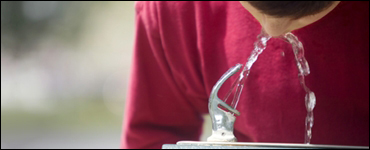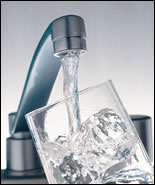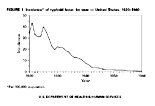CDC Features
National Drinking Water Week is May 4-10

The United States is fortunate to have one of the safest public drinking water supplies in the world. In 2000, the United States alone used 408 billion gallons of water per day (1)! This is the equivalent of approximately 1400 gallons of water per day for every man, woman, and child. This amount is enough to fill 14 standard-size bathtubs and includes both direct water use (drinking, bathing, flushing the toilet, etc.) and indirect water use (watering the lawn, washing the car, growing crops, manufacturing, etc.). (2)
May 4–10, 2008 is National Drinking Water Week.* Each year, the American Water Works Association and an alliance of organizations, including the U.S. Environmental Protection Agency (EPA), sponsor this awareness week to highlight the importance of tap water and the need to reinvest in water infrastructure (3).
Listen to a CDC podcast on Safe Drinking Water (![]() 2 minutes 54 seconds).
2 minutes 54 seconds).
Water's Many Roles

Clean drinking water is
one of the world's most precious resources.
Water plays a critical role in the success of a society, including public health protection, fire protection, and economic support. Access to safe water can lower morbidity and mortality rates. Healthier populations lead to increased productivity, thereby facilitating economic growth. Water's importance in day-to-day business operations as a primary ingredient in many products further leads to economic growth and the provision of jobs. No matter which way you look at it, water plays a vital role in our daily lives.
History of Disinfection
During the past century, many improvements in the health and prosperity of the U.S. population can be attributed to improvements in water quality. In 1908, researchers Chick and Watson developed what would later be known as Chick's Law. Chick's Law describes the length of time and concentration of disinfectant needed to kill microorganisms in water (4). Through her research, Chick determined that as contact time between microorganisms and disinfectant increases, the number of microorganisms in water decreases, thereby showing that a disinfectant can be effective in killing potentially harmful microorganisms in water. This monumental discovery quickly paved the way for researchers and scientists to promote
widespread disinfection of drinking water.
Disinfection of Water - Public Health Protection for 100 Years!
American drinking water supplies are among the safest in the world. The disinfection of water has played a critical role in improving drinking water quality in the United States. With Chick and Watson's discovery of the effectiveness of water disinfection, efforts began to disinfect public drinking water supplies around the country. In 1908, Jersey City, New Jersey was the first city in the United States to begin routine disinfection of community drinking water (5). Over the next decade, thousands of cities and towns across the United States followed suit in routinely disinfecting their drinking water. The incidence of waterborne diseases, such as cholera and typhoid, dropped dramatically, leading to a decrease in overall morbidity and mortality from waterborne illness in the American population. In 1900, the incidence of typhoid fever in the United States was approximately 100 per 100,000 population. By 1920, it had decreased to 33.8 per 100,000 population (6). In 2006, it had decreased to 0.1 per 100,000 population (only 353 cases) and approximately 75% of these cases occurred among persons returning from international travel (7, 8). This decrease in illness can in part be credited to the implementation of drinking water disinfection in community water systems, one of the great public health achievements of the 20th century (9).
For more information on the history of drinking water disinfection and its 100th anniversary, visit www.americanchemistry.com/100years .
Today's Disinfection
Even today, sources of drinking water are still subject to contamination and require appropriate treatment to remove disease-causing contaminants. Contamination of drinking water supplies can occur in the source water as well as in the distribution system after water treatment has already occurred. There are many sources of water contamination, including naturally occurring chemicals and minerals (e.g., arsenic, radon, uranium), local land use practices (fertilizers, pesticides, concentrated feeding operations), manufacturing processes, sewer overflow, and malfunctioning wastewater treatment systems (e.g., septic systems). In the United States, an estimated 4 million to 33 million cases of gastrointestinal illness associated with public drinking water systems occur annually (10, 11). However, these estimates are imprecise and do not include illness in the estimated 45 million people served by small or individual water systems (12) or illness other than gastrointestinal illness.
Public drinking water systems use various methods of water treatment to provide safe drinking water for their communities. Today, the most common steps in water treatment used by community water systems (mainly surface water treatment) include flocculation, sedimentation, filtration and disinfection (see Water Treatment Process, US Environmental Protection Agency). A variety of technologies can be used in each of these steps. For example, sand, gravel, activated charcoal, and membranes can be used for filtration. Chlorine, ozone, and ultraviolet radiation can be used as disinfectants (5). Today, chlorination still remains the most commonly used method for disinfecting drinking water. Many municipal systems that chemically disinfect drinking water use some form of chlorine, either alone or in combination with other methods (13). Chlorine has certain attributes that make it the disinfectant of choice for many public systems, including its ability to kill many different microorganisms and its persistence in water distribution systems resulting in residual protection against microbial regrowth (14). Water may be treated differently in different communities depending on the quality of the water that enters the treatment plant. Typically, surface water requires more treatment and filtration than groundwater because lakes, rivers, and streams contain more pollution and are more likely to be contaminated than groundwater.
The presence of contaminants in water can lead to adverse health effects, including gastrointestinal illness, reproductive problems, and neurological disorders. Chlorine, in addition to killing or inactivating pathogens in water, can react with natural organic matter to produce potentially harmful byproducts. The US Environmental Protection Agency (EPA) regulates drinking water quality in public water systems and sets maximum concentration levels for these chlorine byproducts, in addition to many other water chemicals and pollutants. More information about these rules can be found on EPA's National Primary Drinking Water Regulations Web page. Every water utility is required to provide Consumer Confidence Reports (CCR) to their customers each year. These reports provide information on local drinking water quality, including the water's source, the levels of contaminants found in the water, and the steps customers can take to protect their drinking water.
To find more information about public drinking water quality in general and about your local drinking water CCR, visit:
• CDC — Healthy Drinking Water
• EPA — Consumer Confidence Reports (CCR)
• EPA — What Contaminants May Be Found in Drinking Water?
• EPA — Office of Ground Water and Drinking Water
For those people who do not use community public water systems and who instead use private groundwater wells, more information can be found at:
• EPA — Private Drinking Water Well
A Global Need

A family in rural Madagascar using the Safe Water System - including a bottle of Sûr'Eau solution and a safe container. Photo Credit: Daniele Lantagne.
Worldwide, 1.1 billion people do not have access to an improved water supply, and 2.6 billion people – half of the developing world – lack access to adequate sanitation. That's almost 40% of the world's population! (15, 16) Basic sanitation is described as having access to facilities for the safe disposal of human waste (feces and urine), as well as having the ability to maintain hygienic conditions, through services such as garbage collection, industrial/hazardous waste management, and wastewater treatment and disposal (17). In order to meet the United Nations' Millennium Development Goal to halve the proportion of people without sustainable access to improved drinking water and basic sanitation by 2015, an estimated 1.1 billion people will need to gain access to an improved water supply and 1.6 billion people will need to gain access to basic sanitation (accounting for expected population growth). Even if this Millennium Development Goal is reached by 2015, it will still leave 790 million people (11% of the world's population) without access to an improved water supply and 1.8 billion people (25% of the world's population) without access to adequate sanitation (18, 19).
In much of the world, community water systems do not exist. In areas where access to safe water, appropriate wastewater management, and adequate sewerage systems are not feasible, certain programs, such as CDC's Safe Water System, can empower people to improve and protect the quality of their drinking water through simple, inexpensive technologies to treat and safely store water in their homes. The intervention consists of three steps:
• Point-of-use treatment of contaminated water;
• Safe water storage; and
• Behavior change techniques.
More information on household water treatment is available from the World Health Organization (WHO) at Household Water Treatment and Safe Storage.* For smaller community-based organizations, technical information on household water treatment and safe water storage programs can be found online at Safe Water for the Community: A Guide for Establishing a Community-Based Safe Water System Program* or in hard-copy with a CD by sending an email to safewater@cdc.gov (20).
In other parts of the world where community water systems do exist, some communities struggle to effectively adapt their water and sanitation systems to the community's changing needs. CDC's Global Water, Sanitation, and Hygiene Program is a community-based, integrative approach to improving health and quality of life that incorporates many aspects of a sanitation plan, including:
1. Assessing, monitoring, and managing community water systems from source to tap to ensure the delivery of safe drinking water;
2. Researching the health impacts of sanitation improvements; and
3. Improving the sustainability of community water and sanitation systems.
Programs, such as CDC's Global Water, Sanitation, and Hygiene program, empower communities to take part in their own water safety plan, helping them to build skills for maintaining and sustaining improved water and sanitation programs (21).
Looking into the Future
After 100 years, disinfection remains a cornerstone of modern water treatment. New challenges, such as chemical contamination of water sources, aging water distribution system infrastructure, and increasing water reuse, will require us to remain vigilant in protecting all aspects of our water supply. Scientific breakthroughs and improvements in water safety regulations will ensure that communities continue to receive safe drinking water.
For More Information on Healthy Drinking Water and CDC's Efforts in This Area
- Healthy Drinking Water
- Water-Related Environmental Public Health
- Water-Related Diseases
- Community Water Fluoridation
- Water PLUS / Agua y MAS
- Safe Water System
- Surveillance for Waterborne Disease and Outbreaks Associated with Drinking Water and Water not Intended for Drinking – United States, 2003-2004. (also see Appendix and Glossary)
1. US Geological Survey. Estimated use of water in the United States in 2000.
2. Water Systems Council. Wellcare information for you about water conservation.* ![]()
3. American Water Works Association. Only tap water delivers: drinking water week 2007.
4. Haas CN. Disinfection. In American Water Works Association, Water quality & treatment: a handbook of community water supplies. 5th ed. New York: McGraw-Hill; 1999. p 14.22-14.30.
5. US Environmental Protection Agency. The history of drinking water treatment. ![]()
10. Colford JM, Roy SL, Beach MJ, Hightower A, Shaw SE, Wade TJ. A review of household drinking water intervention trials and an approach to the estimation of endemic waterborne gastroenteritis in the United States. Journal of Water and Health 2006; 4 (Suppl 2):71--88.
11. Messner M, Shaw S, Regli S, Rotert K, Blank V, Soller J. An approach for developing a national estimate of waterborne disease due to drinking water and a national estimate model application. J Water Health 2006; 4 (Suppl 2):201-240.
12. US Environmental Protection Agency. Private drinking water wells.
13. White GC. Handbook of chlorination and alternative disinfectants. 4th ed. New York: Wiley-Interscience Publication; 1999. p. 333.
14. Water Quality & Health Council. The history of chlorine.*
16. US Census Bureau. International programs center: population clocks.
17. World Health Organization. Sanitation.*
18. The United Nations. Millennium Development Goals report 2007.* ![]()
19. Joint Monitoring Programme. Millennium Development Goals assessment report 2006.* ![]()
20. Lantagne DS, Gallo W. Safe water for the community: a guide for establishing a community-based safe water system program. CDC 2008; Edition 1.
Page last updated: May 5, 2008
Content source: Division of Parasitic Diseases, Division of Foodborne, Bacterial and Mycotic Diseases, Division of Emergency and Environmental Health Services, Division of Environmental Hazards and Health Effects, Office of Global Health at NCEH/ATSDR, Agency for Toxic Substances and Disease Registry, National Center for Zoonotic, Vector-Borne, & Enteric Diseases, National Center for Environmental Health, National Center for Chronic Disease Prevention and Health Promotion
Content owner: National Center for Health Marketing
URL for this page: www.cdc.gov/Features/DrinkingWater
*Links to non-federal organizations are provided solely as a service to our users. These links do not constitute an endorsement of these organizations or their programs by CDC or the federal government, and none should be inferred. CDC is not responsible for the content of the individual organization Web pages found at these links



